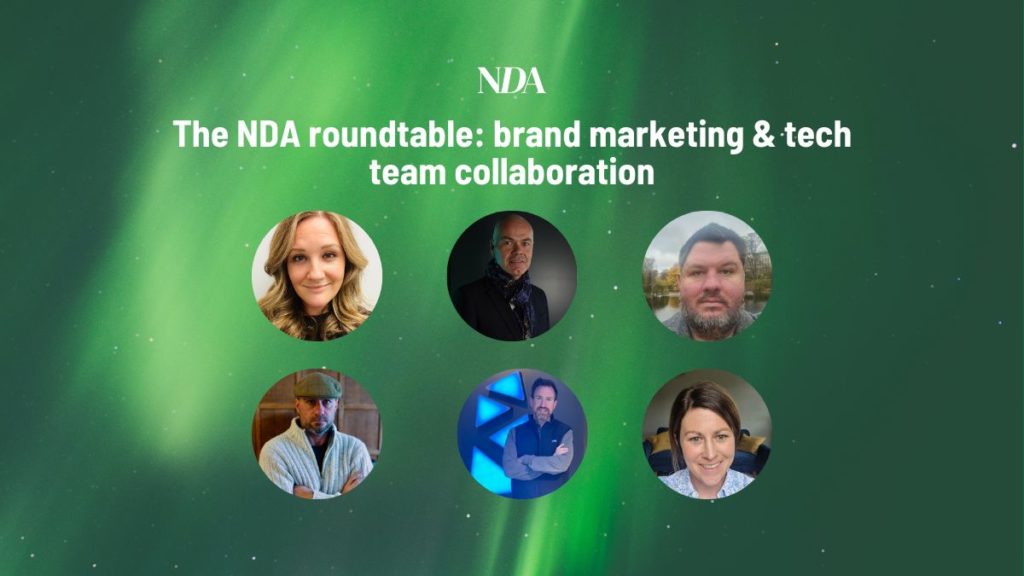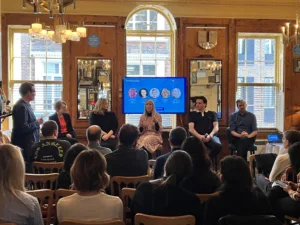The closer advertisers and publishers get to data, the closer their marketing and technology teams are going to have to work together.
Collaboration of this magnitude is going to be vital for these companies. They’re not set up, from an organizational perspective, to develop an integrated response to today’s data challenges, given the corporate tentacles involved. They would stand a greater chance of doing so, however, if the marketers understood more about the technology at their disposal (data management platforms anyone?) and their counterparts on the tech teams knew what marketers actually want. This is and will increasingly become a board-level matter.
The discussion during the second part of our roundtable is a testament to that.
Chaired by NDA’s Editor Justin Pearse, the roundtable featured Matthew Lawson, Chief Digital Officer at Ribble Cycles; Peter Barr Watson, Chief Technical Officer and Director of Digital at The Spectator; Rob Webster, VP of Strategy at CvE; Ulrich Gilot, Head of Media for Global Marketing at Betsson Group; Jim Meadows, Director of Influencer, Media and Partnerships at THG; Katrina Broster, Marketing Performance and Technology Director at the Financial Times; and Cat Daniel, Growth Marketing Director at Monzo Bank.
At its core the rationale for bringing marketing and tech together is pretty straightforward: data privacy is a complex internal matter because sensitive consumer information can live in many places, both in the cloud and on-premise. Knowledge of where this data resides – and just as importantly, who has access to it – is essential. Data is vulnerable to both hacking and insider risks. What’s more, there are issues related to how data is collected, including the policies, and advertising platforms it comes from. All this must be communicated to consumers and end-users with clarity and directness. Big and bold. Fine print is not a fine solution.
“The biggest game changer for us at THG is that essentially the central marketing team has its own team of data scientists, which fit into a central reporting function,” said Meadows.
The benefits are clear: If Meadows wants to understand a particular group of customers who are in a certain territory and see how that group compares to those in another territory then he’s able to get a dashboard built by one of the company’s data scientists within 24 hours.
The benefits of this way of working are clear. Clearer still in a downturn when speed and smarts tend to be the difference between the businesses that grow and those that don’t. And that’s to say nothing of the existential factors around targeting and measuring that are slowly upending the way online advertising works. All told, these are issues too big for just marketers to tackle.
Look at opt-in rates, for example — long considered must for any marketer eyeing that data for all manner of purposes. It’s not always useful. Not when that explicit permission to use someone’s data doesn’t necessarily last long enough to do much with it, said Control v. Exposed’s Webster.
“An opt-in on a Safari browser or an iPhone doesn’t really last more than an hour, which means that marketers can’t really retarget their uses or are more susceptible to lower match rates,” he continued. “Not to mention the fact that measurement won’t work as a result.”
In short, Webster’s comments are a stark warning: marketers would be minded to pay more attention to how the ongoing pivot to privacy is skewing data in the marketing world for companies — for better or worse.
“We’re going back toward more traditional ways of marketing where it’s the interaction someone has with your brand that’s the most important element of the campaign, not how many people were you able to target,” said Ribble Cycles’ Lawson. “To do this companies have to be better aligned internally when it comes to what the marketing team wants and what the technology can do.”
The Financial Times’ Broster had a similar view. In fact, she’s building a team that bridges the marketing and product teams at the publisher to foster better collaboration, especially when it comes to data and technology utilisation. A team like this isn’t only useful, it’s arguably essential when it comes to creative problem solving, developing a plan of action, and the resourcing strategy to deliver that solution.
Not that this sort of collaboration is predicated on big structural change. Sometimes, it’s about the little things.
“I make it a clear strategy for people in my technology department to physically sit with marketing for a couple of half days a week, and they do the same for editorial too,” said Watson. “Ultimately, there’s nothing better than being immersed in other people’s environments to understand some of the challenges that they’re facing. Often, I have junior developers who will sit with a colleague in the commercial department and they’ll come and tell me ‘I had no idea the team over there needed to do this, this is something we can do pretty easily’.”
It’s fostering collaboration on a more fundamental level — something that’s a lot easier to do for businesses that aren’t burdened by legacy structures and behaviors. Certainly, that’s helped Neobank Monzo.
“Our structures and ways of working have been built very recently in a world where marketing tech and digital infrastructure is highly relevant so we don’t have to break down any internal silos in a way that other legacy organisations might have to do,” said Daniel. “If anything, the fact we are scaling so quickly means that we naturally don’t have huge teams of people in the same discipline all sat together but instead group around business or customer needs”
Instead, squads and collectives are formed internally at the online bank to solve problems.
This is easier said than done for those organizations like Betsson Group that are larger, more sprawling and ultimately more complicated to foster that sort of cohesion.
“It’s why one of the bigger issues we need to address is transformation,” said Gilot. “But that’s something that needs to be enabled by external parties that might, through experience in other industries, have a better understanding of the challenges we’re trying to address.
In general, part of the reason being that there might be different internal opinions – shaped by the data they have access to – that may prevent progress being made objectively. Sure, these teams will have some of the answers, but they won’t know enough to be able to facilitate a transformation of the scale needed on their own. External support can bring a different perspective and guidance.”
From a preparation standpoint when it comes to customer and audience data, many advertisers feel that they are behind. The reality is that very few are ahead. What is undeniable is the pressing need for all companies to ensure their marketing and technology teams functions and teams become ever-more integrated to deliver the sort of seamless customer experience expected today









